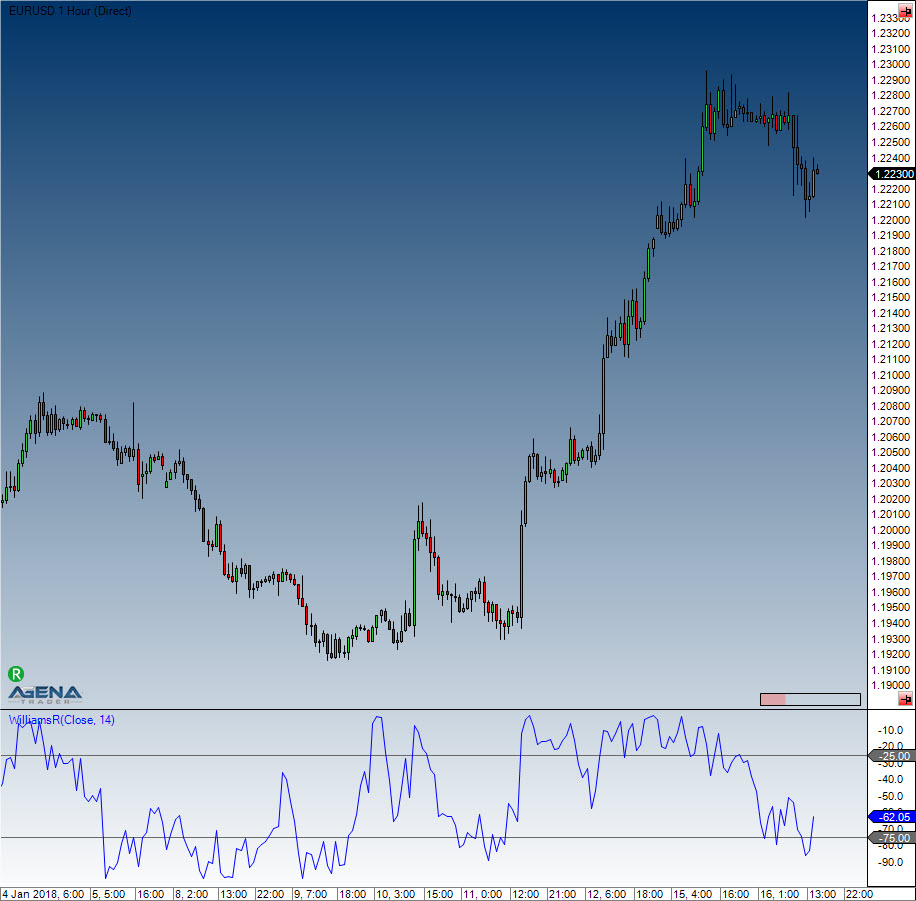Williams %R
Description
Larry Williams developed the Williams %R. It is a momentum indicator, and is the inverse of the Fast Stochastic Oscillator. Williams %R, which is also called simply %R, reflects the level of the close relative to the highest high for the look-back period. The Stochastic Oscillator, on the other hand, reflects the level of the close relative to the lowest low. %R multiplies the raw value by -100 as a means of correcting for the inversion. This means that the Fast Stochastic Oscillator and Williams %R actually produce the exact same lines, with different scaling. The Williams %R fluctuates between 0 and -100. Values between 0 to -20 are deemed overbought, and values from -80 to -100 are seen as oversold. Naturally, signals taken from the Stochastic Oscillator can also be applied to Williams %R.
Interpretation
As with the Stochastic Oscillator, Williams %R reflects the level of the close relative to the high-low range over a given period of time. Assume that the highest high equals 110, the lowest low equals 100 and the close equals 108. The high-low range is 10 (110 - 100), which is the denominator in the %R formula. The highest high less the close equals 2 (110 - 108), which is the numerator. 2 divided by 10 equals 0.20. Multiply this number by -100 to get -20 for %R. Williams %R would equal -30 if the close was 103 (0.30 x -100).
The centerline, -50, is an important level to watch. Williams %R moves between 0 and -100, which makes -50 the midpoint. Think of it as the 50 yard line in football. The offense has a higher chance of scoring when it crosses the 50 yard line. The defense has an edge as long as it prevents the offense from crossing the 50 yard line. A Williams %R cross above -50 signals that prices are trading in the upper half of their high-low range for the given look-back period. This suggests that the cup is half full. Conversely, a cross below -50 means prices are trading in the bottom half of the given look-back period. This suggests that the cup is half empty.
Low readings (below -80) indicate that the price is near its low for the given time period. High readings (above -20) indicate that the price is near its high for the given time period.
Further information
http://www.broker-test.de/finanzwissen/technische-analyse/williams-percent-r/
Usage
WilliamsR(int period)
WilliamsR(IDataSeries inSeries, int period)
WilliamsR(int period)[int barsAgo]
WilliamsR(IDataSeries inSeries, int period)[int barsAgo]Return value
double
When using this method with an index (e.g. WilliamsR(14)[int barsAgo] ), the value of the indicator will be issued for the referenced bar.
Parameters
inSeries Input data series for the indicator
period Number of bars included in the calculations
Visualization

Example
Last updated